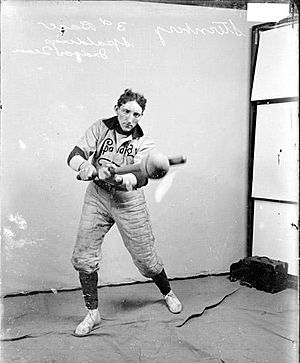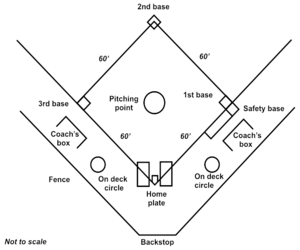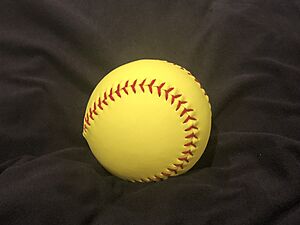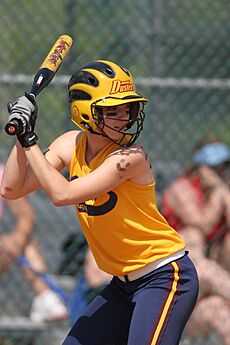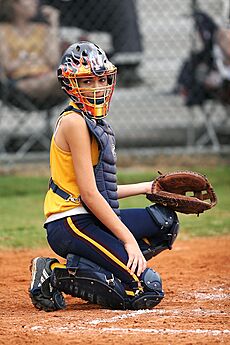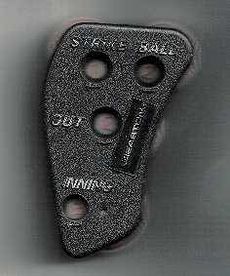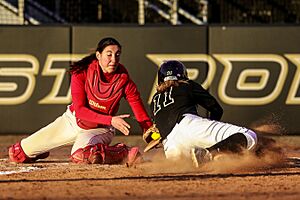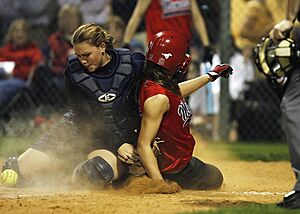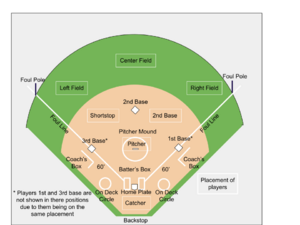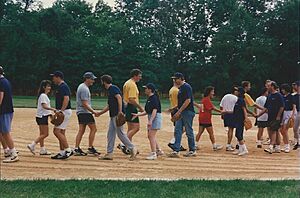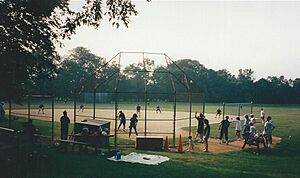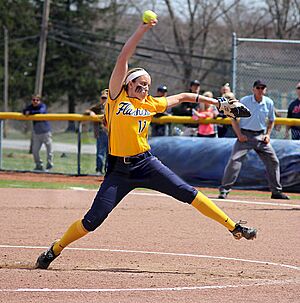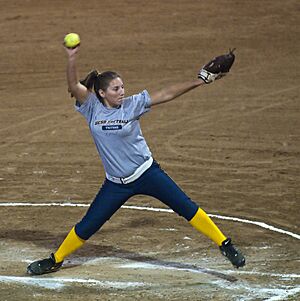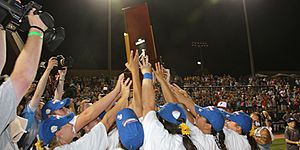Softball facts for kids
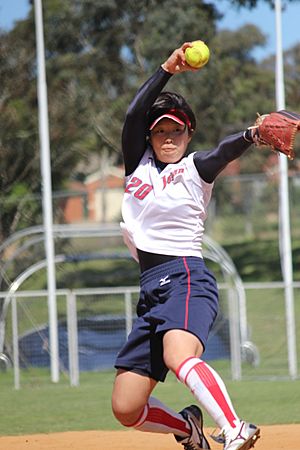
A pitcher about to deliver a fastpitch (windmill pitch), where the ball is still released while the hand is primarily below the ball
|
|
| Highest governing body | World Baseball Softball Confederation |
|---|---|
| First played | 1887, United States |
| Characteristics | |
| Contact | Limited |
| Team members | 2 teams of 9 or 10 |
| Equipment |
|
| Presence | |
| Olympic | 1996–2008, 2020 |
| World Games | 1981, 1985 Invitational: 2009–2013 |
Softball is a fun team sport that is a lot like baseball. It's played with a bigger ball on a smaller field. In softball, pitchers throw the ball underhand, meaning their hand stays below the ball when they release it. People play softball for fun, in college, and even professionally. The game was first invented in 1887 in Chicago by George Hancock.
There are two main types of softball rules: slow pitch softball and fastpitch. Slow pitch is often played for fun, while women's fastpitch softball is an Olympic sport and can be played professionally. The field and equipment can change a bit depending on the type of game, and the age and gender of the players. Bases are usually 60 feet apart. The pitcher's plate can be 35 to 43 feet from home plate. The fence where home runs are hit can be 220 to 300 feet away. The softball itself is usually about 11 or 12 inches around.
Softball rules are a bit different from baseball rules. The game moves faster than baseball because the field is smaller. This means the bases and players are closer to home plate. Pitchers throw the ball underhand from flat ground.
Contents
History of Softball
The very first known softball game happened in Chicago, Illinois, on Thanksgiving Day in 1887. It was played at the Farragut Boat Club. People were waiting to hear the score of a Yale University and Harvard University football game. When the score was announced, a Yale student threw a boxing glove at a Harvard fan. The Harvard fan grabbed a stick and swung at the rolled-up glove. George Hancock, a reporter there, shouted "Play ball!" and the game began. They used the boxing glove as a ball and a broom handle as a bat. This first game ended with a score of 41–40. Since the ball was soft, players caught it without gloves.
George Hancock is known as the inventor of the game. He soon made a 17-inch ball and a smaller bat. The Farragut Club quickly made rules for the game. The sport spread fast. It was first called "Indoor Baseball" because it was meant to help baseball players practice in winter. The next year, the game moved outdoors and was called "Indoor-Outdoor." The first rules were published in 1889.
In 1895, Lewis Rober, Sr. from Minneapolis started outdoor games for firefighters to exercise. This game was called "kitten ball," "lemon ball," or "diamond ball." Rober's game used a 12-inch ball, different from the 16-inch ball used by the Farragut club. Eventually, the 12-inch ball became more popular. The first softball league outside the United States started in Toronto, Ontario, in 1897.
The name "softball" came about in 1926. Walter Hakanson of the YMCA suggested the name at a meeting. Other names for the game included "mush ball" and "pumpkin ball." By 1930, the name softball was used all over the United States. By the 1930s, similar sports with different rules were played across the United States and Canada. A tournament at the 1933 Chicago World's Fair made the game even more popular. By 1936, the Joint Rules Committee on Softball made the rules and name the same across the United States.
Sixteen-inch softball, also called "mush ball," is a direct descendant of Hancock's first game. In this version, players don't wear fielding gloves. Sixteen-inch softball is very popular in Chicago and New Orleans. In New Orleans, it's called "Cabbage Ball" or "batter ball."
The first softball with a cork center was made in Hamilton, Ontario, Canada, by Emil "Pops" Kenesky.
By the 1940s, fastpitch softball became the most popular type. Slow pitch became officially recognized in 1953. Within ten years, it was more popular than fastpitch.
The first British women's softball league started in 1953.
The National Softball Hall of Fame and Museum opened in Oklahoma City, United States, in 1957.
In 1991, women's fastpitch softball was chosen to be played at the 1996 Summer Olympics. The 1996 Olympics also brought new technology to softball, like a study on pitching.
In 2002, 16-inch slow pitch was removed from the International Softball Federation (ISF) rules. However, it is still widely played in the United States under The Amateur Softball Association of America (ASA) rules.
In July 2005, the International Olympic Committee voted to remove softball and baseball from the 2012 Summer Olympics. They were brought back for the 2020 Summer Olympics held in 2021.
How to Play Softball
Fastpitch softball is played by two teams on a large field. Nine players from one team are on the field at a time. Slow-pitch softball usually has ten fielders.
The softball field has a dirt or brick dust infield shaped like a diamond, and a grass outfield. There are four bases on the infield: first base, second base, third base, and home plate. The bases form a square and are usually 60 feet apart. Near the middle of the square is the pitcher's circle. Inside the circle is the "rubber," a small flat plate. The rubber is 35 to 43 feet from home plate in fastpitch, depending on age. In slow pitch, it can be 43, 46, or 50 feet away.
The goal of the game is to score more runs (points) than the other team. You do this by hitting a ball and running around the bases, touching each one. The ball is light and covered with leather. It is 11 to 12 inches around. One or more neutral umpires make sure the game follows the rules. Players can ask for a short break when the ball is not in play.
A game usually lasts seven innings. Each inning has a top half, where the away team bats and tries to score runs. The home team plays defense and tries to get three outs. Then, in the bottom half, the teams switch roles. Some leagues play fewer innings or have a time limit.
To start, the offense sends a batter to home plate. The batting order must stay the same. The defense's pitcher stands on the rubber and pitches the ball towards home plate with an underhand motion. In fastpitch, the pitcher can take one step back before throwing. The batter tries to hit the ball with a bat, which is a long, round stick.
If the pitcher throws three strikes to a batter, the batter is out. A strike happens when a batter swings and misses, or hits the ball foul (out of play). A strike also happens if the batter doesn't swing at a pitch that crosses home plate within the strike zone. In fastpitch, the strike zone is over home plate, between the batter's knees and shoulders. In slow pitch, the ball must land on a mat behind the plate. A pitch outside the strike zone is a ball. If a batter gets four balls, they get to go to first base for free (a "walk"). The umpire behind home plate decides if a pitch is a ball or a strike. Hitting a foul ball while trying to bunt usually results in a strikeout.
The batter tries to hit the ball fair (into the field of play). After a good hit, the batter becomes a base runner and must run to first base. The defense tries to field the ball and throw it to other players to get the runner out. The defense can tag the runner by touching them with the ball when they are not on a base. They can also touch first base while holding the ball before the batter gets there. Runners usually can't be put out when touching a base. Only one runner can be on a base at a time, and runners cannot pass each other. When a ball is hit, runners must try to move to the next base if there are no open bases behind them. For example, a runner on first base must run to second base if the batter hits the ball. The defense can throw to the base the runner is trying to reach (a force out). This can lead to multiple outs: a double play (two outs) or a triple play (three outs), which is very rare.
If a ball hit in the air is caught before it hits the ground, the batter is out. After the catch, runners must go back to their original bases. If the defense throws the ball to that base before the runner returns, the runner is out too, leading to a double play. A runner who stays on base until the ball is caught, or returns to the base (tags up) after the catch, can try to run to the next base. The infield fly rule applies in some situations to stop the defense from getting multiple outs on an easy catch.
Offensive strategy is mainly to hit the ball well so batters can get on base and advance other runners to score runs. Defensive strategy is more complex. Players position themselves differently depending on how many outs there are, where runners are, and who is batting.
Softball Field Layout
The playing field is split into fair territory and foul territory. Fair territory is then divided into the infield and the outfield.
The field is marked by foul lines that meet at a right angle at home plate. The distance from home plate to the outfield fence changes for different fields. The widest part of the field is between the foul poles, which are where the foul lines meet the fence.
Home plate is one corner of a diamond shape. There are bases at each corner. The bases are 15-inch square cushions, usually fastened to the ground. They are numbered counter-clockwise: first base, second base, and third base. Sometimes, there's a special "double base" or "safety base" next to first base in foul territory. This helps prevent players from crashing into each other. The runner runs to the foul part of the double base, while the defense throws to the fair part. These safety bases are more common in women's softball.
The infield is the diamond and the area where infielders play. The outfield is the rest of the space between the foul lines and the outfield fence. The infield is usually dirt, and the outfield has grass.
Near the middle of the diamond is the pitching plate, also called the "rubber." In fastpitch, a 16-foot wide circle is marked around the pitching plate.
A field should have a warning track, 15 to 12 feet from the outfield fence. This helps players know they are getting close to the fence.
There are two coach's boxes in foul territory outside both baselines.
Official Base Distances
| Fastpitch | Slowpitch | Wheelchair |
|---|---|---|
| 60 feet | 60 to 70 feet (depends on league) | 50 feet |
Pitching Distances
| Adult | Youth | Kids | Wheelchair | ||
|---|---|---|---|---|---|
| 13–19 years | 10–12 years | 7–9 years | Under 7 years | ||
| 50 feet | 50 feet | 46 feet | 43 feet | Coach pitch | 28 feet |
| Adult | |
|---|---|
| Female | Male |
| 43 feet | 46 feet |
| Under 16 | |
| 43 feet | |
| 12 and Under | |
| 40 feet | |
| 10 and Under | |
| 35 feet | |
| 8 and Under | |
| Coach pitch | |
Softball Equipment
Softball needs a few key pieces of equipment: a ball, a bat (made of composite, metal, or wood), gloves, uniforms, and protective gear. Helmets are needed for batters and runners. Catchers wear a helmet, shin guards, and a chest protector. Players might also wear cleats, sliding shorts, face masks, and knee sliders.
Softball Ball
Even though it's called "softball," the ball isn't actually soft! It's just less dense and bouncier than a baseball.
The size of the ball changes based on the type of game and age of players. For adult fastpitch, the ball is 12 inches around and weighs between 6.25 and 7 ounces. Kids under 12 use an 11-inch ball weighing between 5.875 and 6.125 ounces. A 12-inch ball is usually used in slow pitch. (For comparison, a baseball is about 9 to 9.25 inches around and weighs 5 to 5.25 ounces.)
The ball is covered in two pieces of leather or fake material, sewn together. The inside of the ball can be made of different materials like cork and rubber, or a special foam.
Before 1993, all softballs were white. That year, a bright yellow ball was first used in college softball. Now, yellow softballs are standard, though white balls are still allowed but rarely seen.
In Chicago, where softball started, they still play a version of slow pitch with a 16-inch ball. Players don't wear gloves for this game. A new 16-inch softball is hard, but it gets softer as it's played with. A very soft, broken-in ball is called a "mush ball." A 16-inch ball is also used for wheelchair softball.
Softball Bat
The bat can be made of wood, aluminum, or composite materials like carbon fiber. Bats can be no longer than 34 inches (86 cm) and no wider than 2.4 inches (6 cm) in diameter. They can weigh up to 38 ounces (1.1 kg). The standard bat barrel (the thick part) is 2.25 inches wide for both slow pitch and fastpitch. Many players like a smaller barrel because it makes the bat lighter and allows for a faster swing.
Some bats are not allowed in games because they are changed to make the ball go farther. For example, bats with thinner walls can make the ball bounce off faster. Some bats might be "doctored" by adding weight to the end or shaving the inside walls to make them more flexible. Also, illegal bats might be painted to look like legal ones.
Softball Gloves
All defensive players wear fielding gloves, made of leather or similar material. Gloves have webbing between the thumb and pointer finger, called the "pocket." Softball gloves are usually bigger than baseball gloves because the ball is larger. No glove bigger than 14 inches can be used in ASA (American Softball Association) games.
Different positions sometimes use different size gloves. Catchers and first basemen use a "mitt," which has a larger pocket and more padding. An outfielder's glove is smaller than a catcher's, usually 12 to 13 inches for fastpitch or 12 to 15 inches for slow pitch. An infielder's glove is the smallest, usually 11.5 to 13 inches. A pitcher's glove is typically 11.5 to 12.5 inches for fastpitch or 11.5 to 13 inches for slow pitch.
No part of the glove can be the same color as the ball, including the seams. Pitchers cannot have any white on their gloves. The umpire decides if any glove color makes it hard for the batter to see the ball.
Softball Uniform
Each team wears a special uniform. This might include a cap, a shirt with team colors and a player's number, sliding shorts (optional), socks, and pants or athletic shorts. All team members must wear the same uniform.
Caps, visors, and headbands are optional for female players and must be the same color. Caps are required for male players. A player who wears a helmet or face mask doesn't have to wear a cap.
Many players use "sliding shorts" to protect their upper thighs when sliding into a base. "Sliders" are padded shin guards that go from the ankle to the knee. They protect the shin and calf from bruises when sliding. Some male players wear long baseball-style pants, while some female players wear shorter versions.
On the back of the uniform, a number from 0 to 99 must be visible. Numbers like 02 and 2 are considered the same. Players' names on the back are optional.
All players must wear shoes. They can have cleats or spikes. Spikes must stick out less than 0.75 inches from the sole. Rounded metal spikes are not allowed. Some high school players can wear metal cleats.
Many recreational leagues don't allow metal cleats to prevent serious injuries when a runner slides into a fielder. In youth leagues (under 15) and co-ed slow pitch, metal spikes are usually not allowed.
Softball Protective Gear
Batters and runners must wear helmets with two ear flaps. Damaged or changed helmets are not allowed. In college fastpitch, players can choose to wear a helmet with or without a face mask. Most girls' fastpitch teams require batters to wear a helmet with a face mask. In male fastpitch, masks are usually only used for medical reasons.
In fastpitch, the catcher must wear a helmet with a face mask and throat protector, shin guards, and a chest protector. Shin guards also protect the kneecap. In youth slow pitch, the catcher must wear a helmet, chest protector, and mask. For adults, there's no rule for catchers to wear a mask, but it's recommended.
Some slow pitch leagues require pitchers to wear a face mask. It's recommended for younger age groups. This helps prevent face injuries.
Umpires in Softball
Decisions about plays are made by umpires. There can be one to seven umpires in a game. There's always one "plate umpire" behind home plate. There can be up to three "base umpires" and three more umpires in the outfield. Most fastpitch games use two umpires: one plate umpire and one base umpire.
Umpires are often called "blue" because of their uniforms. In many games, umpires wear navy blue pants, a light blue shirt, and a navy baseball cap.
Umpires use hand signals and call out their decisions. For "safe" calls, they signal with flat hands moving apart and say "safe." For "out" calls, they raise their right hand in a fist and say "out." Strikes are called by the plate umpire with the same motion as an out call, and they say "strike." Balls are only called verbally. Foul balls are called by extending both arms up and saying "foul ball." Fair balls are shown by pointing towards fair territory.
All umpire decisions are final. Only decisions where a rule might have been misunderstood can be protested. Protests are never allowed for "judgment calls" like balls, strikes, and fouls.
Softball Gameplay
A softball game can last from 3 to 7 innings, or 1 to 2 hours, depending on the league and rules. Teams take turns batting. Usually, the home team bats second. Many players like batting second because they feel they have more control in the last inning.
If the game is tied, extra innings are usually played until one team wins. If the home team is winning after the away team finishes its half of the seventh inning, the game ends because the home team doesn't need to bat again.
In all types of softball, the defensive team is the fielding team. The offensive team is at bat or batting and tries to score runs.
Pitching the Ball
Play often starts with the umpire saying "play ball." After the batter is ready and fielders are in position, the pitcher stands on the pitching plate. The pitcher tries to throw the ball past the batter to the catcher. The throw must be underhand.
The pitcher throws the ball into or near the "strike zone." Pitchers and catchers often try to trick the batter into guessing where the ball will go. Sometimes, a pitcher might intentionally walk a strong hitter to face a weaker one. The strike zone is slightly different in different types of softball. A pitch that goes through that zone is a "strike." A pitch the batter swings at is also a strike, as is any hit ball that lands foul and isn't caught.
A pitch that isn't a strike and the batter doesn't swing at is a "ball." The number of balls and strikes is called the "count." Balls are always said first, like "2 and 1" or "2 and 2." A "full count" is 3 balls and 2 strikes, meaning the next pitch will end the batter's turn unless it's a foul ball.
Slow Pitch Softball
In most slow pitch games, the pitcher lobs the ball high. It must rise above the batter's head and land on a small area behind home plate called "the well." If it lands in the well, it's a strike. These rules make it easier to hit the ball and harder for pitchers to use tricky throws. In other slow pitch games, the pitcher cannot use the "windmill" motion. The arm must stay below the shoulder, but they can still throw with moderate speed.
Fastpitch Softball
In fastpitch softball, the common pitching style is the "windmill" motion. The pitcher swings their arm in a big circle over their head and releases the ball at hip level. The power comes from the pitcher's hip movement.
Pitches can be very fast. In girls' fastpitch, pitchers can throw from 30 to 65 mph or more. The fastest recorded pitch by a woman was 77 mph. Male pitchers can throw around 85 mph. While slower than baseball pitches, the shorter distance in fastpitch means batters have about the same reaction time as in baseball.
Throwing fast isn't always the most important thing in fastpitch. Pitchers can throw "breaking balls" that move in the air, tricking batters. These include pitches that curve inwards (screwball) or outwards (curveball). There are also "riseballs" that go up and "dropballs" that go down. Another common pitch is the "change-up," which looks like a fastball but is much slower, making the batter swing too early. Pitchers use these tricks to get batters out.
An "illegal pitch" happens if the pitcher pushes off the ground from the wrong spot. This often means jumping forward from the pitching plate. If a pitch is illegal, the batter gets a ball, and any runners on base move to the next base. If the batter hits an illegal pitch, the offense can choose to keep the result of the play or take the penalty.
Batters in Softball
The offensive team sends one "batter" at a time to home plate to hit the ball into fair territory. The "batting order" must stay the same throughout the game. In co-ed games, male and female batters usually take turns.
The batter stands in a "batter's box" on either side of home plate. The bat is held with both hands, over the shoulder, facing away from the pitcher. The ball is usually hit with a full swing. The batter steps forward and swings the bat. A bunt is another way to hit, where the batter just taps the ball. There are different types of bunts, like a sacrifice bunt. There's also "slapping," where the batter runs towards first base while swinging. No matter how the batter hits the ball, they must be inside the batter's box when the bat hits the ball. If they step out, they are out.
Once the ball is hit into fair territory, the batter must try to run to first base or beyond. While running to first, they are a "batter-runner." Once they safely reach first, they become a "base-runner" or "runner."
A ball hit high in the air is a "fly ball." A fly ball hit straight up is a "pop fly." A ball hit hard and low through the infield is a "line drive." A ball that hits the ground within the diamond is a "ground ball." If a batted ball hits a player or a base, it's considered to have hit the ground.
A batter can also go to first base if they are hit by the pitch. If a batter is hit, they get first base for free. However, they must try to get out of the way. The umpire decides if the batter tried to move. If not, it's a ball, not a free base.
Getting the Batter Out
The batter is out if:
- They get three strikes (a "strikeout").
- A ball they hit is caught before it touches the ground (a "flyout").
- They run to a base that is already tagged by a fielder with the ball (a "tag out").
- A fielder holding the ball touches a base before the batter gets there, when the batter must run to that base (a "force out").
- In certain other special situations.
Sometimes, if the catcher drops strike three with less than two outs, the batter can try to run to first base if it's empty. The catcher must then throw the batter out at first.
Advancing Around the Bases
If a player hits the ball and reaches a base without an error or an out, it's called a "base hit." Bases must be touched in order, counterclockwise, starting with first base. After hitting, the batter can run as many bases as possible. Reaching first base on one hit is a "single," second base is a "double," third base is a "triple," and home plate is a "home run." Home runs are usually hit over the outfield fence.
If a runner is on a base and another runner becomes entitled to that base, the first runner must move to the next base. For example, if a player hits the ball and there's a runner on first, the runner on first must try to go to second. This is because the batter-runner needs first base.
Runners can advance at their own risk:
- On a hit by another player.
- After a fly ball is caught, if the runner was touching a base when the ball was first touched.
- Automatically (in fastpitch) if a pitch is illegal.
Runners advance without risk of being out:
- When a "walk" (four balls) moves another player to the runner's current base.
- Automatically in certain special situations.
Recently, college rules changed. Now, as long as any part of the batter's foot is in the box when they hit the ball, the play is live. If the batter's whole foot is out of the box, they are out.
Special Situations
If there's a "wild throw" (or "overthrow") that goes out of play, each runner gets two bases from where they were when the throw happened. If a fielder intentionally carries a ball out of play, runners get two bases. If it's unintentional, they get one base.
If there's a "wild pitch" that goes out of play, each runner gets one base.
In fastpitch, runners can try to "steal" bases by running to the next base during the pitch. They must reach the base before being tagged. In fastpitch, runners can steal when the ball is released from the pitcher's hand. Until recently, stealing was not allowed in slow pitch. Now, most slow pitch leagues allow stealing if the runner starts when the ball hits the ground or crosses home plate.
All baserunners must keep one foot on a base until the pitcher throws the ball or until the ball crosses the front edge of home plate (depending on the league).
In fastpitch, if the catcher drops strike three (a "passed ball") with two outs, the batter can try to run to first base if it's empty. The catcher must then try to throw the batter out at first.
In slow pitch, a foul ball with two strikes usually means the batter is out. Stealing in 16-inch softball is very limited.
Scoring Runs
A "run" is scored when a player has touched all four bases in order, going counterclockwise. They don't have to touch all bases in one play. A batter can stay safely on a base and try to advance later.
A run is not scored if the last out is a force out or happens during the same play that the runner crosses home plate. For example, if a runner is on third base and an out is made on another player, the run might not count.
Ending the Game
The team with the most runs after seven innings wins. If the home team is winning after the away team finishes its half of the seventh inning, the game ends.
If the game is tied, play usually continues with extra innings until one team wins. In extra innings, the batting team starts with a runner on second base. This runner is the player who was last supposed to bat.
In games where one team is winning by a lot, the run ahead rule might be used. This ends the game early. In fastpitch, if a team is ahead by 15 runs after 3 innings, 10 after 4, or 7 after 5, they win. In slow pitch, it's 20 runs after 4 innings or 15 after 5 innings. The mercy rule takes effect at the end of an inning.
A game can also be lost by "forfeit." This means one team loses automatically, usually with a score of 7–0. A forfeit can happen if a team doesn't show up, refuses to play, tries to unfairly delay the game, or if a player doesn't leave after being removed from the game.
The umpire can stop play because of darkness or anything that puts players or fans in danger. If four innings have been played and a team is winning, the game counts. If fewer than four innings have been played, the game is not "regulation" and is continued later from where it stopped.
Softball Player Positions
In fastpitch softball, there are nine players on the field. In slow-pitch, there are usually ten. Each player has a specific job. In the infield, there's the pitcher, catcher, first baseman, second baseman, shortstop, and third baseman. In the outfield, there's a left fielder, center fielder, and right fielder. In slow-pitch, there's often an extra outfielder called a "roamer" or "rover."
Pitcher
The pitcher throws the ball from the middle of the diamond. They must start with both feet on the rubber, but neither foot is on the rubber when the ball is released. In softball, pitchers throw underhand from flat ground, not from a mound like in baseball. The pitcher tries to throw the ball into the strike zone. They use a "windmill" motion, swinging their arm in a circle. Pitchers are often tall, flexible, and have strong upper bodies.
Catcher
The catcher is behind home plate in a squatted position. They catch pitches, stop wild balls, call pitches using hand signals, and try to throw out runners. Catchers need to know the number of outs, balls, and strikes. They also need to know where runners are and where the ball should go next. Catchers are strong, smart, quick, and have accurate throws. They wear special gear to protect themselves.
First Baseman
The first baseman plays to the left side of the diamond when facing home plate. Their main job is to catch throws from other players to get a force play at first base. They also field balls hit towards first base. First basemen are usually involved in almost every play. They have quick hands and a good reach. They can be left- or right-handed. Like catchers, first basemen may wear special first base mitts that help them reach throws.
Second Baseman
The second baseman plays between the first baseman and second base. If the ball is hit to the left side of the field, they cover second base. If the ball is hit to right or center field, they help as a "cut-off" for the outfielders. If the ball is hit to the first baseman, the second baseman covers first. They are often involved in double plays. They need to be quick thinkers.
Shortstop
The shortstop fields balls hit to the infield between second and third bases. They also help cover second and third bases and are often part of force plays and double plays. They often throw the ball to the catcher to get runners out at home plate. Shortstops are usually very quick, agile, and think fast. This is one of the hardest positions because many balls are hit in that area.
Third Baseman
The third baseman plays on the right side of the diamond when facing home plate. They field all balls hit their way, including bunts. Third base is called the "Hot Corner" because balls can come off the bat very fast. Third basemen need great reflexes and quick feet. They must have a very strong arm to throw runners out from across the diamond. They are responsible for covering third base unless the ball is hit to them.
Outfielders
The outfielders cover the grassy area behind the infield. They are named for their positions: left fielder, center fielder, and right fielder. Each has a specific job.
Right Fielder
The right fielder plays on the right side of the field, behind the first and second basemen. They back up the infielders and cover the area behind first base. This stops runners from advancing too far if a ball gets past the first baseman. The right fielder usually has the strongest arm of the outfielders because they have the longest throws to make to the bases.
Center Fielder
The center fielder plays in the middle of the outfield, directly behind second base. They are often called the "captains" of the outfield because they communicate with the other outfielders. They cover the area behind second base. The center fielder is usually the fastest of the three outfielders because they have a large area to cover. They also need a strong throwing arm.
Left Fielder
The left fielder plays on the left side of the outfield, behind the third baseman. They back up the infielders and cover the area behind third base. The left fielder needs to be smart and aware of the game situation. They have a full view of the field, players, and runners. They also play a role in "run down" situations between third base and home plate.
Designated Player (DP)
In fastpitch softball, teams often use a designated player (DP). This player bats for one of the defensive players but does not play defense. The DP can also play defense temporarily. The player they replaced, called the "flex," can return to their original position later.
Recreational Softball Play
Types of Leagues
Many Americans play softball for fun. It's played by both men and women, for recreation and competition.
Softball is very popular for adults. Leagues can be "fun leagues," where exercise and friendship are more important than winning, or "serious leagues." Softball teams are often made up of co-workers who play after work. In many US cities, adult softball teams are organized by bars and clubs, sometimes called "beer league" softball. Teams can be all men, all women, or co-ed. Skill levels range from beginners to experts. These leagues are usually slow-pitch or modified pitch.
Co-ed leagues, where men and women play on the same team, often have rules to keep men from dominating the game. For example, rules might say there must be an equal number of men and women, or that male and female batters must take turns. Some leagues require outfielders to stay behind a certain line until a female batter hits the ball.
Changing the Rules
One reason softball is so popular is that its rules can be easily changed. This allows the game to fit different skill levels. For example, in some slow pitch leagues, a batter starts with one ball and one strike. Some leagues limit the number of home runs a team can hit. In others, stealing bases is not allowed. Some groups make home plate a force out for first base, which can reduce scoring.
Co-ed leagues sometimes have rules to make the game fair between genders. For example, an "encroachment line" might require outfielders to stay behind a line until a female batter hits the ball. If they cross the line too early, the batter gets a single base. Some leagues even use different balls for male and female batters.
Some leagues require "limited flight softballs," which don't go as far when hit. Other leagues limit the number of runs that can be scored in an inning, often five.
These rule changes allow children, teenagers, and adults to enjoy softball. There are even leagues for players over 60.
An "offensive pitcher" (or "self pitch") is sometimes used in informal games. The pitcher tries to throw the easiest pitch for the batter to hit. There are no walks, and the batter gets a set number of pitches (usually 3 or 4) to hit the ball. If they don't hit it fair, they strike out. The pitcher doesn't play defense, and if a batted ball hits the pitcher, the batter is often out.
Some leagues reduce the number of pitches for a walk or strikeout. For example, one strike is an out, and two balls is a walk. This makes games shorter, which is good for doubleheaders or when daylight is limited.
Many leagues also have a second first base, usually orange, next to the main one. The batter runs through the orange base to avoid collisions. Some leagues also have an alternate home plate and make plays at home always force plays. This helps reduce "pickles" (when a runner is caught between bases), which can be hard on older players' ankles and knees.
Indoor Softball
Softball was first meant to be played indoors, but it's usually played outside now. The indoor version is sometimes called Arena Softball. Indoor softball rules are generally similar to outdoor rules. Only the wall behind the batter is foul territory. Other walls are fair. Often, there's a small area on an outfield wall that gives a home run if the ball hits it. Pitching is usually slower indoors, or a pitching machine is used for younger players.
Softball Pitching Styles
In softball, a pitch is when the pitcher throws the ball towards home plate to start a play. All pitches are thrown underhand, meaning the hand is below the waist. Pitchers use different grips, stances, and arm motions to throw various pitches. These changes affect the ball's speed, path, and movement, making it harder for the batter to hit.
Pitchers choose which pitch to use based on many things. This includes the type of batter, if there are runners on base, how many outs there are, and the score.
Signaling Pitches
The catcher usually chooses the type of pitch by giving hand signals to the pitcher. In more advanced games, coaches might give signals to batters or runners for special plays. A runner on base might see the catcher's pitch sign and hint it to the batter.
Pitching Styles
The International Softball Federation (ISF) recognizes three main pitching styles:
- Fastpitch
- "Modified" fastpitch
- Slowpitch
Fastpitch Style
The pitching distance is 35 feet for younger players and 43 feet for older players. College and international pitchers throw from 43 feet. Pitches can go over 65 mph.
- Windmill or "Full-windmill"
* The pitcher starts with her arm at her hip. She swings the ball in a circle over her head, completes the circle back down at her hip, and snaps her hand to release the ball.
- Figure 8
* The ball is not brought over the head. Instead, it moves down and behind the body and back in one smooth motion, making a figure eight shape.
- Illegal Pitches
* "Crow-hopping" and "leaping" are illegal. This means the pitcher pushes off the ground from the wrong spot or jumps before releasing the ball.
"Modified" Fastpitch Style
- "Modified" Windmill
* This is like a windmill pitch, but the arm doesn't go over the head in a full circle. Instead, it goes behind the body (limited back swing) and then directly forward for the release.
Slowpitch Style
The pitching distance is 50 feet. The pitch must be thrown high so that it falls onto the plate to be a strike. Strikeouts are rare in slowpitch. Pitchers try to throw the ball with a high enough arc so the batter can't hit a hard line drive. Pitches are usually 25 to 35 mph, giving batters plenty of time to react.
- Half Windmill
* This is a high-arc pitching technique. * The pitch must have an arc between 6 and 12 feet high. If the arc isn't high enough, the umpire will call it an illegal pitch.
Types of Pitches
Fastballs
The fastball is usually the first pitch a player learns.
- Two-seam fastball
- Four-seam fastball
Breaking Balls
These pitches move late in their flight, making them hard to hit.
- Dropball (moves downward)
- Riseball (moves upward)
- Curveball (curves sideways)
- Screwball (curves sideways in the opposite direction of a curveball)
- Drop-curve
- Rise-curve
- Backdoor curve (starts outside the strike zone and curves back over the plate)
- Drop screw
- Backdoor screw (like a backdoor curve but spins differently)
Changeups
The changeup is a slower pitch that looks like a fastball. Its slower speed and tricky delivery are meant to confuse the batter's timing. Pitchers use different grips and techniques for changeups, such as:
- Flip (or "Back-hand flip") release
- Stiff wrist release
- Circle grip changeup
- Knuckle grip changeup
Other Off-Speed Pitches
- Knuckle curveball
- Floater (used in slow-pitch, thrown with fingertips for a high arc)
- Knuckleball (moves slowly and unpredictably)
Professional Softball Leagues
Women's Professional Fastpitch (WPF) is a professional women's softball league in the United States. It started in June 2022. Before that, it was known as the National Pro Fastpitch (NPF) and Women's Pro Softball League (WPSL).
In the late 1970s and early 1980s, there was a short time for men's professional softball in the United States.
International Softball Competition
Softball is played in over a hundred countries. The main organization for the sport is the World Baseball Softball Confederation (WBSC), which has many member countries. The WBSC holds world championships in different categories.
The Amateur Softball Association (ASA) is the main governing body for softball in the United States. Other groups like the United States Specialty Sports Association (USSSA) and International Softball Congress (ISC) also exist.
The WBSC holds the ISF Women's World Championship tournaments. These tournaments are held every four years and use fastpitch rules. There are also several World Cups.
New Zealand won the Men's World Championship in 2013 and 2019. Australia won in 2009.
In the Junior Men's World Championship in 2012, Team Argentina won.
Softball at the Summer Olympics
In the Women's Softball World Championships, the United States is a very strong team. They won three of the past four Olympic tournaments and seven World Championships. The current Junior Women's World Champion is the United States.
Women's softball was first played at the 1996 Summer Olympics. It was then removed after the 2008 Summer Olympics. Softball and Baseball were not included in the 2012 and 2016 Olympics. In 2012, the leaders of the International Softball and Baseball Federations announced they would work together to be included in the 2020 Olympics. They suggested having men's baseball and women's softball played at one location for 7 to 10 days. Softball and Baseball were brought back for the Tokyo 2020 Summer Olympics, which happened in 2021. The United States team went into the gold medal game undefeated but lost 2-0 to Japan. Japan became the Tokyo 2020 Softball Olympic Gold Medalists.
Countries Playing Softball
New Zealand
New Zealand is the most successful country in men's world championship softball, winning their eighth title in 2019. The New Zealand women's team has also won World Championship titles. Softball is widely played in New Zealand and is the second most popular summer sport after cricket.
Australia
Softball is played in all states and territories in Australia and at all school levels. The game helps people stay fit and healthy. Australia has produced some of the world's best men's softball players, like Adam Folkard and Andrew Kirkpatrick. Australia has excellent softball teams because of good coaching and training.
Japan
Japan has a long history with softball, played at all levels. Many high schools and colleges have softball programs. Like baseball, softball in Japan is very competitive. Japan's win over the United States at the 2008 Olympics shows how advanced their play is.
China
After winning a silver medal at the Atlanta Olympics, China made softball a priority. The game is played in most schools. With a large population, China is producing many great players. Chinese teams often visit the US and now have similar coaching and training programs.
Europe
Softball is played in almost every country in Europe, mostly fastpitch. Every two years, an open women's European fastpitch championship is held with over twenty national teams. Italy and Netherlands are the best nations. In the men's division, eight to ten national teams compete for the European championship, with the Czech Republic, the Netherlands, and Denmark leading.
United States
In America, there are over 1,500 college softball teams at different levels: NCAA Division 1, Division 2, Division 3, NAIA, and NJCAA. There are 5 professional women's softball teams: the Aussie Peppers, the Chicago Bandits, the Cleveland Comets, the California Commotion, and the Canadian Wild.
Competitive fastpitch softball for girls is becoming more popular. Across the US, thousands of teams play in tournaments year-round. Often, the main goal is not just winning, but getting college coaches to watch players. Competitive teams start as young as eight years old. Depending on the team, they might travel across the United States or even to Canada for many weeks.
There are many different groups that organize softball, like USSSA, ASA, ISA, NSA, WSL, USFA, Triple Crown, and SASL. One of the biggest is the Amateur Softball Association (ASA). It was started in 1933 and has over 240,000 teams. The USSSA, founded in 1968, is the only group that still has a men's major slow-pitch program. The United States also has a competitive women's softball team that plays in international tournaments. They represented the US at the Olympics until softball was removed.
The ASA (founded 1933) is one of the largest groups for the game in the United States. The World Baseball Softball Confederation (WBSC) sets rules for play in over 110 countries. The USA Softball Men's Fast Pitch National Team has won five World Championships. In the Pan-American Games, Team USA has reached the finals every time men's fastpitch was played.
Images for kids
See also
 In Spanish: Sóftbol para niños
In Spanish: Sóftbol para niños



